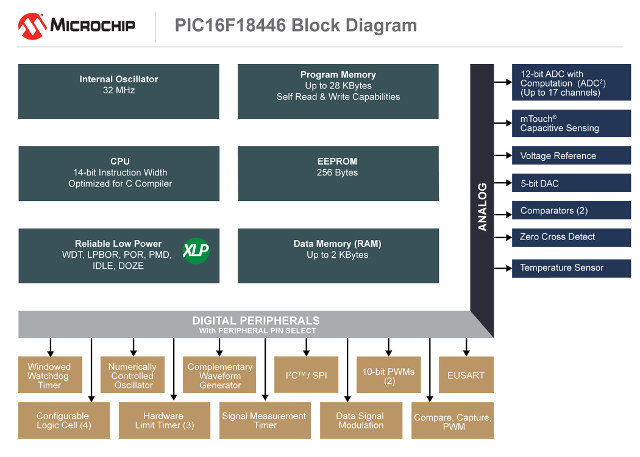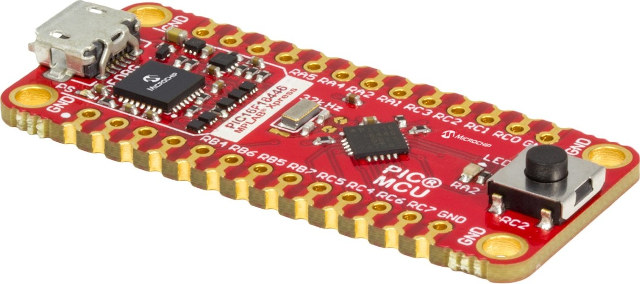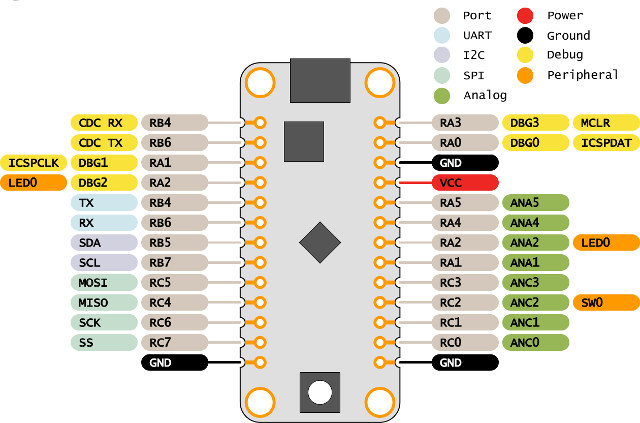Microchip announced several PIC and AVR microcontrollers with “Core Independent Peripherals and Intelligent Analog” in February with respectively PIC16F18446 family of microcontrollers, and ATmega4809 megaAVR microcontrollers, with the latter to be integrated in the next generation of Arduino boards.
The company is now organizing a promotion for their PIC16F184xx product family where they give away a PIC16F18446 MPLAB Xpress evaluation board!

Key features of PIC16F184 micro-controllers:
- High-precision 32 MHz internal oscillator
- 7 to 28 KB Flash program memory
- 512 bytes to 2 KB of SRAM
- 12-bit ADC with computation (ADC2), up to 24 channels
- 5-bit DAC
- eXtreme Low Power (XLP) with sleep currents down to 50 nA
- IDLE and DOZE low power modes
- Memory Access Partition (MAP)
- Device Information Area (DIA)
- Signal Measurement Timer (SMT)
- Hardware Limit Timer (HLT)
- Windowed Watch Dog Timer (WWDT)
- Peripheral Pin Select (PPS)
- Peripheral Model Disable (PMD)
- Configurable Logic Cell (CLC)
- Two comparators
- Numerically Controlled Oscillator (NCO)
- Zero Cross Detect (ZCD)
- On-chip temperature sensor
- 10-bit PWMs
- Complementary Waveform Generator (CWG)
- Data Signal Modulator (DSM)
- EUSART, SPI, and I2C
- Packages in 14- to 28-pins
The MCU family is supported by MPLAB Code Configurator (MCC), a free software plug-in that provides a graphical interface to configure peripherals and part of MPLAB X IDE and the cloud-based MPLAB Xpress IDE. For a quick look at the latter, you could read my hands-on experience in Getting Started with MPLAB Xpress Board and Online IDE.

If you want to play the MCU, you can get MPLAB Xpress PIC16F18446 evaluation board – now given away for a limited time – with the following specifications:
- MCU – Microchip PIC16F18446 microcontroller with 2KB SRAM, 28KB flash memory
- Expansion – 26-pin with GPIOs, I2C, UART, SPI, analog inputs, analog outputs, debug interfaces, VCC and GND
- Misc – Yellow user LED, user button
- nEDBG embedded debugger – Programming, Virtual COM port (CDC), and green board status LED.
- Power Supply – 5V via micro USB port

Further information about the board can be found on the product page, and you can apply with a free sample here.
Thanks to Theguyuk for the tip.

Jean-Luc started CNX Software in 2010 as a part-time endeavor, before quitting his job as a software engineering manager, and starting to write daily news, and reviews full time later in 2011.
Support CNX Software! Donate via cryptocurrencies, become a Patron on Patreon, or purchase goods on Amazon or Aliexpress





This reminds me of the good old days when PIC16F controllers were used to decrypt satellite and digital terrestrial/cable TV…
No open source toolchain, no thank you.
What, it’s the same enhanced mid-range PIC we’ve come to know and love, right down to the 128-word program memory banks and the PCLATH kludge. sdcc should work just fine. As for flash programming, the spec is open, so the FOSS guys should be on it sooner or later.
“…know and love…”?
I’m still carrying the emotional scars of working with these processors 15 years ago. I could never figure out how a vendor could call their architecture “compiler-friendly” when they have an extremely limited hardware stack and a lot of operations are only possible using The One Working Register.
Now I’m flabbergasted that anyone would still be using them. What possible reason could there be?
Maybe are you too young to understand where the computers come from ? Did you ever tried to program a 8086, 6502, 6800 or Z-80 ?
Hey, @zoobab do you happen to know open source toolchain alternative to this thingy (and the bus pirate) ?